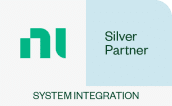Automation of Tests
Sirona
Sterilization of Dental Equipment Requires Testing
When you are at the dentist’s office, it is imperative that you can trust the equipment used on you to be properly cleaned and sterilized. Usually, an autoclave is used for this sterilization. The autoclave is a closed container where the equipment is placed. The container gets filled with steam while pressure and temperature are carefully controlled. During this standardized cycle, the dental tools placed in the autoclave are properly sterilized and lubricated.
For Sirona, manufacturer of dental equipment and autoclaves, this means that they use a great deal of resources testing their autoclaves before shipping them out to their customers. This process, however, consisted of several time-consuming and manual tasks that they sought to automate to reduce testing time and free up labor resources.
“We need to make the testing of our sterilizing autoclaves easier without compromising the quality.” Sirona utilized a lot of technical and specific knowhow in their testing of their autoclaves – for instance, when detecting very fine leaks in the autoclaves. This experience and knowhow had to be included in the automated production, and since production of medical equipment is under strict regulations, the demands on documentation of the process were high.
TestStand and LabVIEW Made the Difference
At GPower, we helped Sirona move their manual testing processes to TestStand – a standardized test sequence manager. Additionally, we build the product test in to the production line which ended up also featuring a burn-in and repairing station – all controlled by a Measurement Execution System (MES) and programmed using LabVIEW.
Since Sirona has moved all their product testing into TestStand, it has become much easier, faster, and cheaper for them to maintain and expand their test programs. Furthermore, the MES-integration and the new automated leak-test have improved the work processes and also reduced the cost of each single produced unit. This is partially because it is no longer necessary for Sirona to monitor each partial test of the autoclaves just as the necessity of some of the old manual task has been eliminated. All because of the increased level of automation provided by our solutions.
An additional benefit from the automation have been that the development department at Sirona now can utilize the same testing in developing new prototypes. Automating Sirona’s testing procedures has, moreover, increased the efficiency in the development department. Furthermore, it has also improved the quality of the newly developed autoclaves since they undergo testing much sooner in the production process now.








